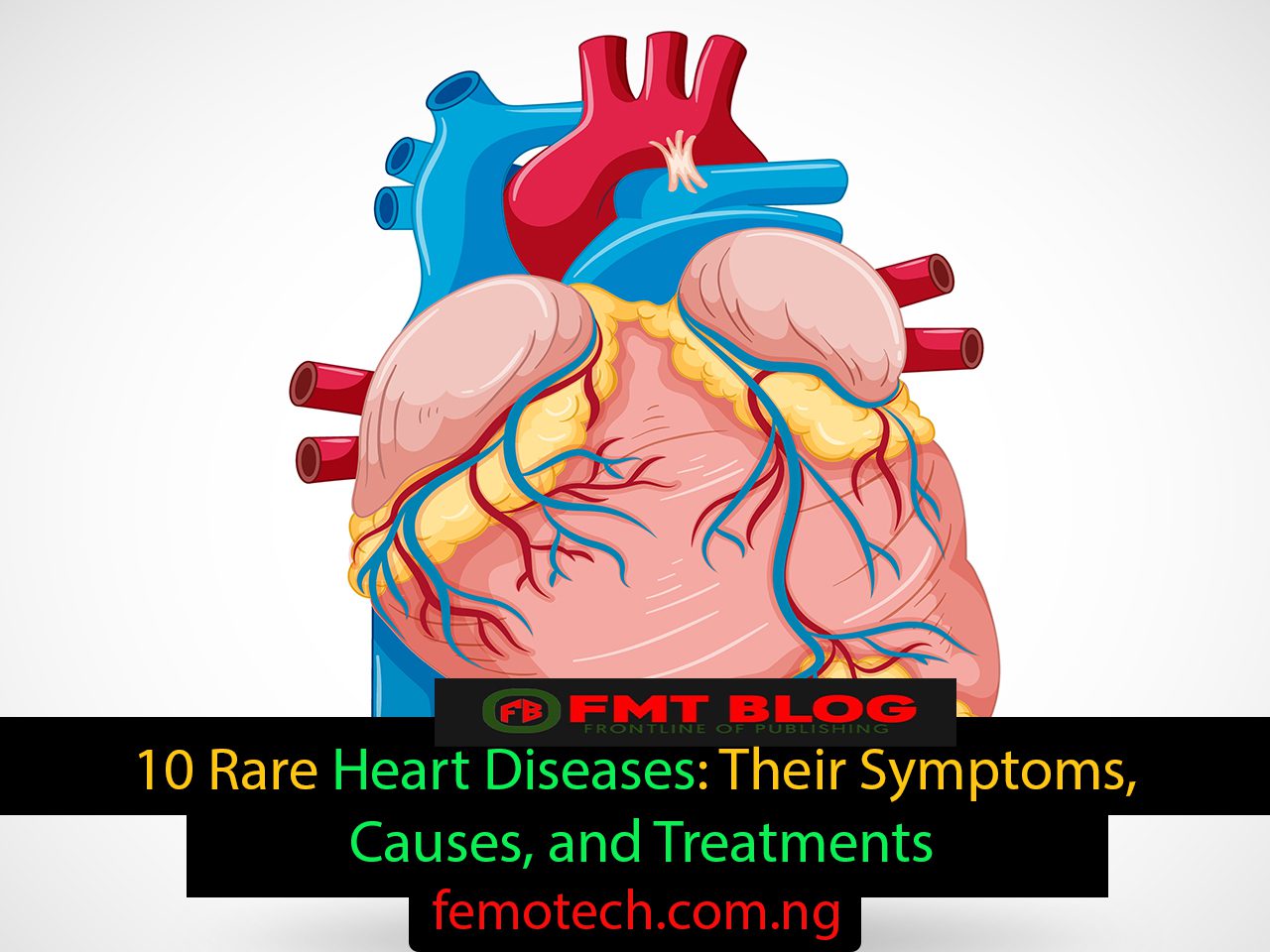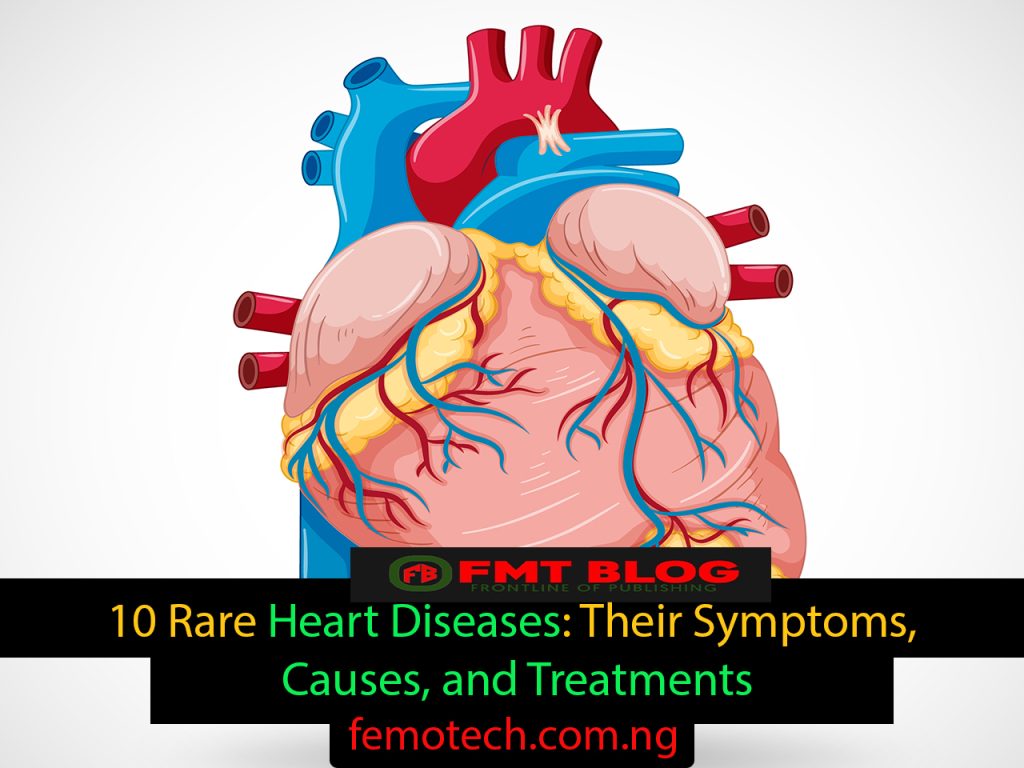
Discover the top 10 rare heart diseases, their symptoms, causes, and treatments. Learn how to identify and manage these 10 rare heart diseases.

Introduction
The human heart is a remarkable organ, tirelessly pumping blood throughout our body to deliver oxygen and nutrients to every cell. While most people are familiar with common heart conditions like coronary artery disease and heart failure, a lesser-known group of rare heart diseases can also impact individuals and families. These uncommon conditions, though affecting a smaller population compared to their more prevalent counterparts, pose significant challenges in terms of diagnosis, treatment, and overall well-being.
In this article, we will look into the 10 rare heart diseases, exploring their characteristics, causes, symptoms, and potential treatment options. We will also touch upon the challenges of identifying the absolute rarest heart disease and offer valuable resources for individuals and families living with these uncommon conditions.
1. Familial Hypertrophic Cardiomyopathy (HCM)
Familial hypertrophic cardiomyopathy (HCM) is a genetic condition that causes thickening (hypertrophy) of the heart muscle, specifically in the lower chambers (ventricles). This thickening can obstruct blood flow out of the heart, leading to various complications.
Symptoms of HCM:
- Shortness of breath, especially during exertion
- Chest pain
- Fatigue
- Palpitations (irregular heartbeats)
- Lightheadedness or dizziness
Causes of HCM:
HCM is caused by mutations in genes responsible for heart muscle proteins. These mutations are inherited from a parent, making HCM a familial condition.
Diagnosis and treatment options for HCM:
The diagnosis of HCM typically involves a combination of tests, including an electrocardiogram (ECG), an echocardiogram (ultrasound of the heart), and genetic testing. Treatment options vary depending on the severity of the condition and may include medications, lifestyle modifications, and surgical procedures.
Am I at risk for HCM?
If you have a family history of HCM, your risk is higher. However, it’s important to note that not everyone with a family history will develop the condition, and conversely, some individuals with HCM may not have a known family history.
2. Arrhythmogenic Right Ventricular Dysplasia (ARVD)
Arrhythmogenic right ventricular dysplasia (ARVD) is one of the 10 rare heart diseases affecting the heart muscle. In ARVD, the muscle tissue in the right ventricle (lower right chamber) is replaced by fatty or fibrotic tissue, weakening the heart muscle and disrupting its electrical signals. This can lead to abnormal heart rhythms (arrhythmias) and potentially life-threatening complications.
Symptoms of ARVD:
- Palpitations (feeling like your heart is racing, fluttering, or skipping beats)
- Fainting (syncope)
- Dizziness or lightheadedness
- Shortness of breath
- Chest pain
Causes of ARVD:
Similar to HCM, ARVD is primarily a genetic condition caused by mutations in genes responsible for heart muscle proteins. However, some cases may not have a clear family history, suggesting other potential contributing factors are yet to be fully understood.
Diagnosis and treatment options for ARVD:
Diagnosing ARVD often involves a combination of tests like an electrocardiogram (ECG), an echocardiogram, and cardiac magnetic resonance imaging (MRI). Genetic testing may also be performed to confirm the presence of mutations. Treatment options aim to manage symptoms, prevent complications, and improve quality of life. This may involve medications, lifestyle changes, implantable devices like defibrillators, and, in severe cases, surgery.
What are the complications of ARVD?
One of the major concerns with ARVD is the risk of developing sudden cardiac death (SCD), particularly in young individuals. This is why early diagnosis and proper management are crucial to reducing the risk of complications.
3. Ebstein’s Anomaly
Ebstein’s anomaly a rare congenital heart diseases present at birth. In this condition, the tricuspid valve, which separates the right atrium (upper chamber) and right ventricle (lower chamber) of the heart, is malformed and displaced downward. This abnormal positioning affects the pumping function of the heart and can lead to various complications.
Symptoms of Ebstein’s anomaly:
- Shortness of breath, especially during exertion
- Fatigue
- Irregular heartbeats (palpitations)
- Rapid heart rate (tachycardia)
- Bluish skin color (cyanosis) in severe cases
Causes of Ebstein’s anomaly:
This heart disease, which is one of the 10 rare heart diseases, the exact cause of Ebstein’s anomaly is not fully understood, but it is believed to be related to the abnormal development of the heart during pregnancy. Some studies suggest possible genetic factors may play a role, but more research is needed.
Diagnosis and treatment options for Ebstein’s anomaly:
Diagnosing Ebstein’s anomaly often involves prenatal screening during pregnancy, including echocardiograms. After birth, further evaluation with an echocardiogram, chest X-ray, and ECG is usually conducted. Treatment options depend on the severity of the condition and may involve medications, lifestyle modifications, or surgery to repair or replace the tricuspid valve.
Can Ebstein’s Anomaly be detected during pregnancy?
Early detection of Ebstein’s anomaly during pregnancy is crucial for prompt intervention and improved outcomes. Advanced prenatal screening techniques like fetal echocardiography can help identify the malformation and allow for the planning of delivery and management strategies after birth.
4. Takotsubo Cardiomyopathy (Broken Heart Syndrome)
Takotsubo cardiomyopathy, also known as broken heart syndrome, is also one of the 10 rare heart diseases that mimics a heart attack but is not caused by a blocked coronary artery. It typically occurs in response to a sudden emotional or physical stressor, such as the death of a loved one, a severe illness, or a major accident.
Symptoms of Takotsubo cardiomyopathy:
- Chest pain, similar to a heart attack but often described as a squeezing or burning sensation
- Sweating
- Nausea and vomiting
- Feeling faint or lightheaded
Causes of Takotsubo cardiomyopathy:
The exact cause of Takotsubo cardiomyopathy is still under investigation, but it’s believed to be related to a surge in stress hormones, such as adrenaline, which can temporarily weaken the heart muscle, particularly in the left ventricle.
Diagnosis and treatment options for Takotsubo cardiomyopathy:
Diagnosing Takotsubo cardiomyopathy often involves tests like an electrocardiogram (ECG), an echocardiogram, and blood tests to rule out a heart attack. Treatment is primarily focused on managing symptoms and supporting the heart’s recovery. This may involve medications to help with heart function, blood pressure control, and anxiety reduction. In most cases, the heart muscle recovers over time with proper care and support.
How does Takotsubo Cardiomyopathy differ from a heart attack?
While both conditions can cause chest pain and shortness of breath, Takotsubo cardiomyopathy does not involve blocked coronary arteries like a heart attack. Additionally, ECG and other diagnostic tests can help differentiate between the two conditions.
5. Tetralogy of Fallot (TOF)
Tetralogy of Fallot (TOF) is one of the congenital rare heart diseases that combines four abnormalities present at birth:
Pulmonary stenosis: Narrowing of the valve connecting the right ventricle to the pulmonary artery, obstructing blood flow to the lungs.
Ventricular septal defect (VSD): A hole in the wall separating the lower chambers (ventricles) of the heart, allowing blood to flow from the right ventricle to the left ventricle without going to the lungs for oxygenation.
Right ventricular hypertrophy: Thickening of the right ventricle due to the increased workload of pumping blood against the narrowed valve.
Overriding aorta: The aorta, the main artery carrying blood out of the heart, is positioned abnormally over both ventricles due to the VSD.
Symptoms of Tetralogy of Fallot:
- Bluish skin color (cyanosis) due to a lack of oxygen in the blood
- Shortness of breath, especially during exertion
- Fatigue
- Rapid heart rate (tachycardia)
- Clubbing of fingers and toes (enlarged and rounded fingertips and toenails) in some cases
Causes of Tetralogy of Fallot:
The exact cause of TOF is unknown, but it is believed to be a combination of genetic and environmental factors. Some studies suggest possible links to maternal factors like certain medications or infections during pregnancy.
Diagnosis and treatment options for Tetralogy of Fallot:
Early diagnosis, often through prenatal screening and echocardiograms, is crucial for TOF. Treatment typically involves surgery during infancy or childhood to repair the heart defects and improve blood flow. Open-heart surgery is often the approach, and specific techniques may vary depending on the individual’s anatomy and severity of the condition.
Can Tetralogy of Fallot be treated with surgery?
Surgery is the mainstay of treatment for TOF. In most cases, surgery is performed during infancy or childhood to address the heart defects and improve blood flow. Advances in surgical techniques have significantly improved outcomes for individuals born with TOF, allowing them to lead active and healthy lives.
Follow us on socials → Telegram | X/Twitter | Facebook | WhatsApp |WhatsApp Channel |Mobile App
Conclusion
This concludes our exploration of the first first part of the 10 rare heart diseases. As we’ve seen, these rare conditions, while affecting a smaller population, present unique challenges and require specialized attention. Early detection and proper management are crucial for improving the lives of individuals living with these conditions.
But our journey doesn’t end here! The exploration of the 10 rare heart diseases encompasses a wider spectrum. In Part 2 of this article, we delve into five more rare heart diseases, unveiling their characteristics, causes, and potential treatment options. Prepare to be surprised by the fascinating complexities of the human heart and the diverse ways these rare conditions can manifest.
Don’t miss out on this opportunity to expand your knowledge and gain valuable insights into the world of rare heart diseases. The journey to a healthier heart starts with understanding, and this exploration continues in Part 2!



